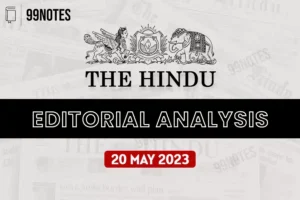23 May 2023 : The Hindu Editorial
The Hindu Editorial
23-May-2023
Daily Current Affairs For UPSC ,The Hindu Editorial Summary
1. Slow withdrawal: on the RBI and the ₹2,000 note
Topic: GS3 – Indian economy.
Context:
-
-
-
The Reserve Bank of India (RBI) has announced the withdrawal of ₹2,000 banknotes from circulation.
-
This move has triggered the memories of the economically disruptive demonetization of ₹500 and ₹1,000 notes in 2016.
-
-
Issue:
-
-
-
The RBI states that the withdrawal is part of its “Clean Note Policy” and does not alter the legal tender status of the withdrawn notes.
-
However, the September 30 deadline for exchanging or depositing the withdrawn currency has created difficulties for individuals using the notes for daily transactions.
-
The sudden decision to withdraw the notes raises questions about the rationale, especially since the printing of new ₹2,000 notes was halted in 2018-19.
-
The RBI claims that lower denominations have become adequately available, making the ₹2,000 notes unnecessary.
-
The RBI argues that the withdrawn notes were at the end of their estimated lifespan and constituted a small percentage of the total notes in circulation.
-
Unlike this sudden move, previous withdrawals of older banknotes by the RBI have been conducted gradually over time.
-
The lack of transparency and administrative changes surrounding the withdrawal undermine trust in the RBI’s handling of currency policies.
-
-
2. It’s time to ensure safer skies.
Topic: GS3 – Aviation sector.
Context:
-
-
-
In 1997, an NGO filed a PIL in the Karnataka High Court expressing concerns about the safety of the second runway at Mangalore airport.
-
The PIL was dismissed, and a subsequent PIL in 2002 warning of a potential crash was also dismissed.
-
-
Issue:
-
-
-
The NGO challenged the verdict in the Supreme Court, which refused to interfere but emphasized the need for compliance with laws and environmental norms during airport construction.
-
Despite the warnings, government agencies did not comply with laws and norms, leading to a tragic crash in Mangalore in 2010, resulting in the loss of 158 lives.
-
The Supreme Court dismissed the PIL that highlighted the violations, placing the blame solely on the pilot and ignoring systemic issues.
-
The DGCA and AAIB investigations failed to identify the root causes of accidents and prevent their recurrence, pointing to a lack of accountability and transparency.
-
The Ministry of Civil Aviation established the CASAC to identify deficiencies and provide corrective measures, but warnings and recommendations should have been addressed.
-
The failure to address safety deficiencies and prioritize training and occupational safety jeopardizes India’s aviation industry standards.
-
The induction of a large number of aircraft without a sufficient number of qualified professionals and the financial audits of airlines by the DGCA further compromise safety.
-
The lack of action by the judiciary in addressing the issues raised by PILs related to the Mangalore crash raises concerns about the future of aviation safety in India.
-
-
Issues with aviation safety in India:
-
-
-
Failure to comply with laws and environmental norms during airport construction.
-
Lack of accountability and transparency in investigations into accidents.
-
Systemic deficiencies in training and safety audits by the DGCA.
-
Non-conformance of Indian airports to international safety standards.
-
Neglect of occupational safety and fatigue issues.
-
An inadequate number of qualified professionals in critical positions.
-
Financial audits are leading to airlines’ failure and potential compromises in safety.
-
Lack of implementation of recommended safety measures.
-
The commercial interests of airlines are prioritized over safety considerations.
-
Insufficient focus on training and occupational safety, putting lives at risk.
-
-
Other issues for India’s aviation sector:
-
-
-
Infrastructure constraints: India’s airports, especially in major cities, often face capacity constraints due to outdated infrastructure, lack of expansion plans, and limited runway capacity. This leads to congestion, delays, and inefficiencies in operations.
-
Regulatory framework: The regulatory framework governing the aviation sector in India is sometimes seen as complex – creating obstacles for airlines and hindering the growth and competitiveness of the industry.
-
Air traffic management: India’s airspace management and air traffic control systems need improvement to handle the growing air traffic efficiently. Modernization of these systems is necessary to reduce congestion, improve safety, and enhance operational efficiency.
-
High operating costs: The operating costs for airlines in India, including fuel prices, airport charges, and taxation, are relatively high. These factors impact the profitability and competitiveness of airlines operating in the country.
-
Skill shortages: There is a shortage of skilled aviation professionals in various areas, including pilots, engineers, technicians, and air traffic controllers. Addressing this shortage and ensuring adequate training and development programs are crucial for the sustainable growth of the sector.
-
Connectivity challenges: Despite the significant growth in air travel, there is still a lack of connectivity to several remote and underdeveloped regions of the country.
-
Costly and limited access to capital: Access to capital for airlines and aviation infrastructure projects can be challenging and costly in India. This hampers the ability of airlines to invest in fleet expansion, infrastructure development, and modernization.
-
Regulatory hurdles for foreign investment: Restrictions and complex regulations regarding foreign direct investment in the aviation sector can discourage international airlines and investors from entering the Indian market, limiting competition and innovation.
-
Security concerns: Ensuring robust security measures in airports and on flights is essential to maintain passenger safety and confidence. Constant vigilance and investment in security infrastructure and technology are necessary to mitigate potential threats.
-
Environmental sustainability: The aviation industry contributes to carbon emissions and environmental pollution. Implementing measures to reduce the sector’s carbon footprint and promoting sustainable practices, such as fuel efficiency and adoption of cleaner technologies, are vital for the long-term sustainability of the aviation sector.
-
-
Way Forward:
-
-
-
Infrastructure development: Focus on expanding and modernizing airport infrastructure, including runways, terminals, and air traffic control systems. This will help alleviate congestion, improve efficiency, and enhance the passenger experience.
-
Regulatory reforms: Simplify and streamline the regulatory framework to reduce bureaucracy and promote ease of doing business in the aviation sector. Create a transparent and investor-friendly environment that encourages domestic and foreign investment.
-
Skill development: Invest in training and development programs to address the shortage of skilled aviation professionals. Collaborate with educational institutions and industry stakeholders to establish robust training programs for pilots, engineers, technicians, and other critical positions.
-
Airspace management and technology upgrade: Modernize air traffic management systems to improve airspace capacity, reduce congestion, and enhance safety. Deploy advanced technologies such as satellite-based navigation systems to optimize routes and improve operational efficiency.
-
Regional connectivity: Prioritize the development of regional airports and air connectivity to underserved areas. Encourage the operation of smaller aircraft and incentivize airlines to serve remote regions, promoting economic development and tourism.
-
Encourage foreign investment: Ease restrictions on foreign direct investment in the aviation sector to attract international airlines and investors. Foster partnerships and collaborations with global players to bring expertise, capital, and technological advancements.
-
Security enhancement: Continuously upgrade and strengthen security measures in airports and on flights to ensure the safety and confidence of passengers. Implement advanced screening technologies and adopt international best practices in aviation security.
-
Environmental sustainability: Develop and implement strategies to reduce carbon emissions and promote sustainable practices in the aviation sector. Encourage the use of biofuels, invest in energy-efficient technologies, and promote research and innovation in eco-friendly aviation solutions.
-
Public-private partnerships: Foster collaborations between the government, private sector, and industry stakeholders to drive innovation, investments, and sustainable growth in the aviation sector. Encourage public-private partnerships for infrastructure development, skill training, and technology adoption.
-
Tourism promotion: Enhance air connectivity to popular tourist spots, offer incentives for airlines to operate routes to tourist destinations, and facilitate seamless travel experiences for international visitors.
-
Air cargo development: Recognize the importance of air cargo in driving economic growth and trade. Invest in dedicated air cargo infrastructure, develop cargo hubs, and streamline customs and logistics processes to facilitate efficient and timely movement of goods.
-
Public awareness and engagement: Conduct public awareness campaigns to promote the benefits and safety of air travel. Educate the public about their rights as passengers, disseminate information on aviation regulations and safety procedures, and engage with the public to address their concerns and feedback.
-
International collaboration: Strengthen partnerships and collaboration with international aviation organizations, regulatory bodies, and industry stakeholders. Participate in global forums to share best practices, benchmark against international standards, and learn from the experiences of other countries.
-
Continuous monitoring and evaluation: Establish mechanisms for regularly monitoring and assessing the aviation sector’s performance, safety standards, and regulatory compliance. Implement a robust system for collecting and analyzing data to identify trends, risks, and opportunities for improvement.
-
-
Steps taken by the Indian government in this regard:
-
-
-
Regional Connectivity Scheme (UDAN): The government launched the UDAN scheme to enhance air connectivity to underserved and unserved regions of the country. It provides financial incentives to airlines to operate flights on regional routes and offers affordable airfares to passengers.
-
Open Sky Policy: The government implemented an Open Sky Policy, which allows unrestricted air connectivity between Indian airports and select countries. This promotes international travel, tourism, and trade.
-
Make in India in Aerospace: The government’s “Make in India” campaign focuses on promoting domestic aerospace manufacturing. It aims to attract investments, facilitate technology transfer, and encourage the establishment of aerospace manufacturing facilities in India.
-
National Civil Aviation Policy (NCAP): The government introduced the NCAP in 2016 to provide a comprehensive framework for the development of the aviation sector. It covers various aspects such as regional connectivity, airport infrastructure, air cargo, aviation security, and ease of doing business.
-
Greenfield Airports: The government has initiated the development of new greenfield airports in various parts of the country to enhance air connectivity and promote economic development in those regions.
-
Simplification of Air Travel Procedures: The government has taken steps to simplify air travel procedures, including e-visa facilities, self-check-in kiosks, and the implementation of biometric-based passenger identification systems at airports.
-
-
3. Karnataka’s new yet daunting journey to development
Topic: GS3 – Indian economy – regional development.
Context:
-
-
-
Karnataka aspires to become a trillion-dollar economy by 2032, with a 17%-18% CAGR in its Gross State Domestic Product (GSDP).
-
-
Issue:
-
-
-
The state has a history of political instability, with 22 different configurations of governments in 35 years.
-
The services sector is the most significant contributor to Karnataka’s GSDP, making up more than two-thirds of the economy. There is a need to focus on
-
agriculture to increase productivity and diversify the economy.
-
Karnataka’s Finance Secretary has been in his position for an unbroken 10 years, helping maintain fiscal stability.
-
Karnataka ranks among the top states regarding revenue surplus, capital expenditure, and low outstanding liabilities.
-
The incoming government will face the challenge of maintaining fiscal discipline while fulfilling promises that may impact the fiscal deficit.
-
Karnataka has dues to power generation companies and electricity distribution utilities, which may worsen with additional promises of free power.
-
Skilling initiatives must be strengthened, emulating successful models like Telangana’s Telangana Academy for Skill and Knowledge (TASK).
-
Agriculture reforms should focus on deepening the value chain, implementing the agriculture startup policy, and improving credit access for farmers.
-
A modern startup policy is crucial for the IT sector, one of the world’s largest startup ecosystems.
-
Cumulative investments of ₹150 lakh crore will be required to achieve the trillion-dollar economy goal, with a significant contribution from private and government capital expenditure.
-
-
Steps that can be taken for better regional development:
-
-
-
Economic diversification: Encourage the development of a diverse range of industries and sectors in the region to reduce dependence on a single industry. Promote entrepreneurship and provide support for small and medium-sized enterprises (SMEs) to foster economic growth and job creation.
-
Investment in human capital: Focus on education and skill development programs to equip the local workforce with the knowledge and skills required by industries. Establish vocational training centres and collaborate with educational institutions to provide industry-relevant training.
-
Promotion of tourism: Identify and promote the region’s unique attractions, cultural heritage, natural resources, and historical sites to attract tourists. Develop tourism infrastructure, such as hotels, resorts, and recreational facilities, and provide training to local communities to participate in the tourism sector.
-
Encourage regional collaboration: Foster partnerships and collaboration between different regions within the country to share resources, knowledge, and best practices.
-
Access to finance: Improve access to finance for businesses and entrepreneurs in the region through initiatives such as microfinance programs, venture capital funds, and easy loan facilities. Provide incentives for financial institutions to invest in regional development projects.
-
Good governance and transparent policies: Ensure a conducive business environment through transparent policies, ease of doing business reforms, and efficient governance. Streamline administrative processes, reduce bureaucratic hurdles, and provide a clear regulatory framework for businesses.
-
Environmental sustainability: Promote sustainable development practices by incorporating environmental considerations into regional development plans. Encourage renewable energy projects, waste management systems, and conservation of natural resources to achieve long-term environmental sustainability.
-
Empower local communities: Involve local communities in the decision-making process and empower them to actively participate in the development initiatives. Encourage community-led development projects, promote local entrepreneurship, and support initiatives that address the specific needs and aspirations of the local population.
-
-
Implications of skewed regional development:
-
-
-
Economic disparities: Concentration of economic growth in certain regions can widen the gap between prosperous and underdeveloped regions. This can result in income inequality, poverty, and disparities in living standards, leading to social unrest and migration from underdeveloped regions to urban centers.
-
Unemployment and migration: Skewed development can lead to limited job opportunities in underdeveloped regions, forcing the workforce to migrate in search of better employment prospects. This can result in overcrowding and strain on infrastructure in already developed areas while leaving behind underutilized human capital in the neglected regions.
-
The strain on resources: Overconcentration of economic activities in specific regions can put excessive strain on resources such as water, energy, and land. This can lead to environmental degradation, resource depletion, and unsustainable exploitation of natural resources.
-
Social tensions and conflict: Regional disparities can create social tensions and conflicts between regions, communities, and ethnic groups. Neglected regions may feel marginalized and neglected, leading to grievances and potential conflicts with more developed regions.
-
Inefficient resource allocation: Neglected regions may have untapped potential and resources that could contribute to overall economic growth if properly harnessed and developed.
-
Political instability: Regions experiencing persistent underdevelopment and neglect may feel alienated from the political process, leading to political instability and dissatisfaction with the central government. This can manifest in demands for regional autonomy, separatist movements, or political unrest.
-
Infrastructure gaps: Uneven development can result in significant infrastructure gaps between regions. Underdeveloped regions may lack basic infrastructure such as roads, electricity, healthcare facilities, and educational institutions, hindering their overall development and quality of life.
-
Brain drain: Concentration of opportunities in specific regions can contribute to a brain drain phenomenon, where skilled professionals and talented individuals migrate to developed regions in search of better prospects. This can deprive underdeveloped regions of skilled workforce and hinder their own development efforts.
-
Health and education gaps: Neglected regions may suffer from inadequate healthcare facilities and educational institutions, resulting in health and education gaps. This can lead to lower life expectancy, higher mortality rates, and limited access to quality education, perpetuating the cycle of underdevelopment.
-
-
Steps taken by the Indian government to address the situation:
-
-
-
Special Category Status: The government has granted Special Category Status to certain states and union territories, providing them with additional financial assistance and benefits to accelerate their development. These regions typically have a history of economic and infrastructural disadvantages.
-
Backward Regions Grant Fund (BRGF): The BRGF was launched to provide financial support for bridging development gaps in backward regions. It aims to strengthen local governance, improve infrastructure, and enhance livelihood opportunities in these areas.
-
Government initiatives: such as Pradhan Mantri Gram Sadak Yojana, Skill India Mission, Digital India programme, Make in India initiative, Pradhan Mantri Awas Yojana etc have been launched to bridge the developmental gaps across various regions.
-
Northeast Development: The government has undertaken various measures to promote the development of the northeastern states, including infrastructure projects, special economic zones, and connectivity initiatives like the Act East Policy. These efforts aim to bridge the development gap between the northeastern region and the rest of the country.
-
-
4. Solidarity for peace.
Topic: GS2 – International relations.
Context:
-
-
-
The G-7 summit held in Hiroshima aimed to convey a message of global solidarity for peace.
-
-
Issue:
-
-
-
The summit issued a “Hiroshima Vision Statement on Nuclear Disarmament” and emphasized the significance of leaders visiting the peace memorial.
-
President Biden’s attendance and President Zelenskyy’s surprise arrival highlighted the importance of the summit.
-
The G-7 members issued a statement on Ukraine, imposing sanctions on Russia, but did not provide a clear path for dialogue and ending the war.
-
The G-7 group is unrepresentative of the world today, accounting for less than a third of global GDP and a tenth of the world’s population.
-
The G-7 lacks representation from major economies like China and India and does not include the fastest-growing GDPs or significant energy providers.
-
The summit failed to propose concrete measures to address global challenges such as financing for the developing world and climate change.
-
The focus now shifts to the G-20 summit in Delhi, where hopes are placed on a more inclusive outlook and comprehensive global consensus on key issues.
-
-
For Enquiry

23 May 2023 : The Hindu Editorial

23 May 2023 : Daily Current Affairs

22 May 2023 : PIB

22 May 2023 : Daily Current Affairs

22 May 2023 : The Hindu Editorial

20 May 2023 : PIB

20 May 2023 : The Hindu Editorial

20 May 2023 : Daily Current Affairs

Madhavacharya (1238–1317 or 1199–1278)

Industrial Infrastructure UPSC
The Hindu 23 May 2023 : The Hindu Editorial The Hindu Editorial
12-May-2023
Daily Current Affairs For UPSC ,The Hindu Editorial Summary
Facebook-f
Twitter
Youtube
1.Marriage…
Daily Current Affairs 23 May 2023 : Daily Current Affairs DAILY CURRENT AFFAIRS
23-May-2023
Daily Current Affairs For UPSC ,Daily Current affairs of The hIndu…
PIB 22 May 2023 : PIB PRESS INFORMATION BUREAU
22-May-2023
Daily Current Affairs For UPSC ,The PIB ( Press Information Bureau…
Daily Current Affairs 22 May 2023 : Daily Current Affairs DAILY CURRENT AFFAIRS
22-May-2023
Daily Current Affairs For UPSC ,Daily Current affairs of The hIndu…
The Hindu 22 May 2023 : The Hindu Editorial THE HINDU EDITORIAL
22-May-2023
Daily Current Affairs For UPSC ,The Hindu Editorial Summary
Facebook-f
Twitter
Youtube
1. Delhi’s…
PIB 20 May 2023 : PIB PRESS INFORMATION BUREAU
20-May-2023
Daily Current Affairs For UPSC ,The PIB ( Press Information Bureau…
The Hindu 20 May 2023 : The Hindu Editorial The Hindu Editorial
20-May-2023
Daily Current Affairs For UPSC ,The Hindu Editorial Summary
Facebook-f
Twitter
Youtube
1. Among…
Daily Current Affairs 20 May 2023 : Daily Current Affairs DAILY CURRENT AFFAIRS
20-May-2023
Daily Current Affairs For UPSC ,Daily Current affairs of The hIndu…
evaluation of the rajput states upsc Madhavacharya (1238–1317 or 1199–1278) Madhavacharya was born in a Brahmin family in the Udupi district of Karnataka.
Madhavacharya propounded…
Infrastructure Industrial Infrastructure UPSC Infrastructure is the set of provisions that serve a country, city, or other area. It encompasses…


